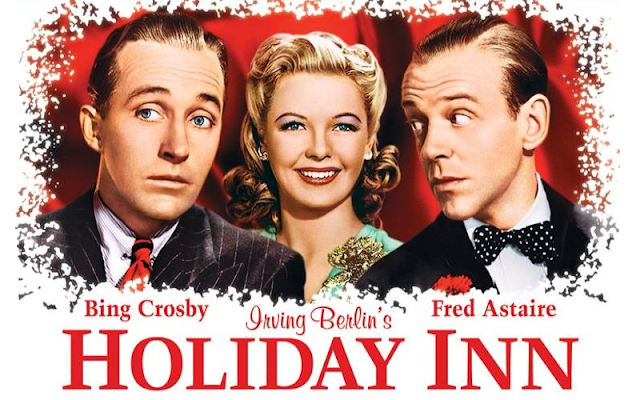White Christmas from the finale of the 1954 MGM film of the same name.
It is a bit early to break out perhaps the most iconic of the classic Golden Age of American Secular Christmas songs, but last night my wife Kathy Brady-Murfin and I took in a production of the stage version of Irving Berlins’s White Christmas by Theatre 121 at the Woodstock Opera House. It was at least the third production of a version of the film classic we have seen. It is a staple of both the professional and community holiday theater. It is both comfortable and an invitation to sing along.
You probably know that the most played and beloved secular American Christmas song—White Christmas—was first featured in the 1942 movie musical Holiday Inn. It was not one of the elaborate production numbers but was a simple parlor piano duet by Bing Crosby and Marjorie Reynolds. It was not expected to be a hit, but it struck a deep chord with American GIs far from home. The rest is history.
The idea of a film based on country inn that opened as an entertainment venue only on holidays was Irving Berlin’s own. So was the idea of writing original songs for each holiday. Eventually he penned 12 new songs including White Christmas and another soon-to-be seasonal classic Happy Holidays. Also included in the film was Easter Parade, written by Berlin for the 1933 Broadway revue As Thousands Cheer.
Berlin signed with Paramount Pictures in 1940 to write the songs for a film based on his story idea. The studio intended it to showcase its most bankable star—Bing Crosby. The studio signed Mark Sandrich, who had helmed four of the great Fred Astaire-Ginger Rodgers musicals at RKO. He brought Astaire along, on loan from his studio for a dream team matchup of two of the biggest movie musical stars.
White Christmas was introduced in 1942's Irving Berlin's Holiday Inn.
Casting the female lead was trickier. Paramount, not the richest of studios, already faced a big payroll with its stars, Irving Berlin and Sandrich plus the costs of the elaborate production numbers, could not afford an A list star who they would have likely had to borrow from a major studio. After rummaging around the role of Linda Mason, the fresh-faced wanna-be performer, went to Marjorie Reynolds, a starlet rather than a star, who had mostly worked in two-reel Westerns with the likes of Tex Ritter and young Roy Rogers. Famous or not Reynolds turned out to be a lovely singer and accomplished dancer who had no trouble keeping up with the men.
The second female lead went to an even lesser known performer, Virginia Dale, a former Miss California and a hoofer as the faithless Lila Dixon.
The film premiered on August 4, 1942 and was an immediate hit—Paramount’ top grossing film of the year. It easily returned its hefty $3.2 million budget. The music from the show also did well. As expected the Valentine’s Day romantic ballad Be Careful, It’s My Heart did well even if it never exactly became a Berlin standard. But White Christmas really took off after a slow start breaking into the Billboard chart in late October and staying at or near the top for the next 11 weeks. It went on to win the 1943 Academy Award for Best Song.
The Decca Records studio recordings of songs from the film was issued in a 78 rpm album but did not include the original female stars. White Christmas from this album was later released as a single and became a legendary success.
Crosby’s studio recording of the song originally included in Decca 78 rpm album of songs from the show was released as a single and sold so briskly that it damaged the master recording and Crosby had to go back in the studio to record it again in 1947. That version easily became a #1 hit and is the one most heard today. In 1949 Crosby included it in his Merry Christmas album which has never gone out of issue. It became the title song of the 1954 Technicolor film White Christmas starring Crosby, Rosemary Clooney, Danny Kay, and Vera-Ellen, another all-Irving Berlin musical that became a holiday classic of its own.
Crosby in his Santa hat graced the covers of countless LPs, singles, and CDs.
Taken together the 1942 and ’47 versions of the song are estimated 50 million copies, the most by any release and the biggest-selling single worldwide of all time. It returned to the Billboard Pop Chart twenty times before the magazine created a distinct Christmas chart for seasonal releases.
White Christmas is also the most recorded song of all time with over 500 covers by other artists, several of which became hits in their own right.




No comments:
Post a Comment